Displaying items by tag: Joe FitzGerald
Joe Fitzgerald 1922–2016
Joe Fitzgerald of Cork went from among us a month and more ago at the age of 94. That month provides us with an added perspective for a full appreciation of his well-lived life afloat and ashore. It enhances our understanding of just how completely land and sea can become happily intertwined in life around Cork Harbour and city.
When that way of life is being lived by someone with Joe’s quiet yet always enthusiastic appreciation of the opportunities for good times in the world of boats and sailing, we find we’re looking at a long life which was a gentle inspiration and encouragement to all who knew him.
He seemed to find the perfect balance between running a demanding yet fulfilling business in the fashionable heart of Cork city, and relaxing through sailing and the company of sailing folk. The family firm in which he succeeded his father was the iconic Fitzgerald menswear, a tailoring and clothing company and shop which Joe elevated to such a reputation for quality in all areas that it’s said the young Louis Copeland, that legend of men’s tailoring, readily travelled from Dublin in order to enhance his skills by working with Joe Fitzgerald, learning from his notable eye for fabric and finish.
All these skills were allied to an astute yet very proper business aptitude. Nevertheless a good week’s work would be celebrated at its conclusion in proper style with a host of such quiet charm that when you found yourself relaxing after business hours in Joe’s company in the heart of Cork city, the sense of being in the midst of true civilisation was central to the mood of the evening, and that mood of generous enjoyment would then be carried on to the weekend’s projects in and around boats and sailing.
Despite his small stature - it’s thought that it was his longtime friend Stanley Roche who first called him “The Tiny Tailor”, though others in Cork will claim it was a northern friend – Joe was a tower of strength around boats, and he first acquired his sailing skills through spending his boyhood summers with an uncle who had a Brixham trawler converted to a sailing cruiser, and based in Crosshaven.
Although during his working years his family home was in Blackrock, Crosshaven remained his sailing home for the rest of his long life, and for his final decade he was a resident of the apartments which had been developed in the former Grand Hotel just across the road from the side door to the Royal Cork Yacht Club, where he was wont to meet his special circle of friends.
This link to shore living in Crosshaven went back to the late 1930s when Joe and some young contemporaries rented a house in the village on a year-round basis. They became much involved with the local dinghy sailing scene through the Cork Harbour Sailing Club, where the inspiration was top international helm Jimmy Payne, who saw to it that the club had a fleet of International 12 sailing dinghies available for charter at 10 shillings for half a day at a time when The Emergency engendered by World War II might have made access to sailing difficult
 The International 12s racing at Crosshaven in the 1940s. Photo courtesy RCYC
The International 12s racing at Crosshaven in the 1940s. Photo courtesy RCYC
Soon, a core of useful dinghy sailing experience built up. But by 1943 the waters around neutral Ireland were less directly affected by the war, and the Irish Cruising Club organised a race from Crosshaven around the Fastnet. Lest this seem callous at a time when war was still being waged, it should be noted that several naval and military officers on active service with the Allied forces managed to arrange leave in order to participate.
Among the boats taking part was the famous Gull from Crosshaven, one of the seven participants in the first international Fastnet Race of 1925. Although her legendary skipper Harry Donegan had died in 1940, his son Harry Jnr continued the family ownership of Gull, and for that race of 1943, he included the young Joe Fitzgerald in the crew. As a result, Joe Fitzgerald was elected a member of the Irish Cruising Club in 1944 on the proposal of Harry Donegan Jnr, and today the Fitzgerald ICC membership of 72 years has the air of the eternal record to it.
 The Donegan family’s Gull, a veteran of the first international Fastnet Race of 1925, aboard whch Joe Fitzerald qualified for Irish Cruising Club membership in 1944. Photo: Courtesy RCYC
The Donegan family’s Gull, a veteran of the first international Fastnet Race of 1925, aboard whch Joe Fitzerald qualified for Irish Cruising Club membership in 1944. Photo: Courtesy RCYC
Joe Fitzgerald was also busy in 1944 in other ways afloat, as he was continuing to play a key role in the dinghy sailing of the Cork Harbour Sailing Club, and 1944 saw the first races by CHSC in International 12s against Sutton Dinghy Club for “The Book”, the monumental volume in which each year’s racing is recorded by the winning team. It continues today with Sutton DC still in the picture, but it’s the mighty Royal Cork Yacht Club itself which now represents Cork Harbour, and has done so since 1970. Nevertheless it was a surprise for participants in 1988’s event in Crosshaven when Joe Fitzgerald was asked to speak at the dinner, and he gave his typically dry-humoured account of the racing in 1944 all of 44 years previously and waxed enthusiastic about the goodwill which The Book has generated ever since.
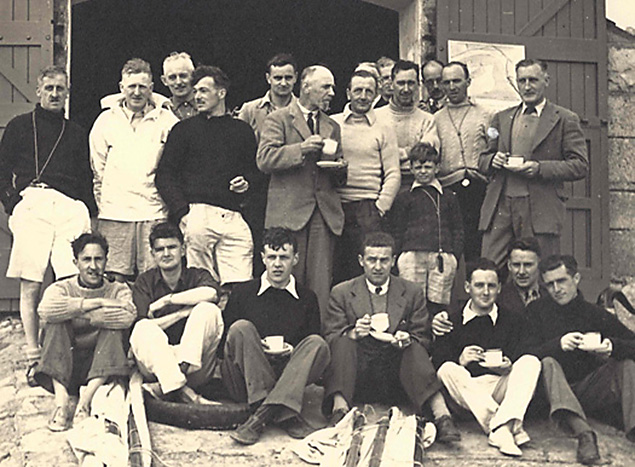 The teams racing for “The Book” at Sutton Dinghy Club in 1944. Joe Fitzgerald, on the Cork Harbour SC team, is third from the right of those seated at front. Photo courtesy SDC/RCYC
The teams racing for “The Book” at Sutton Dinghy Club in 1944. Joe Fitzgerald, on the Cork Harbour SC team, is third from the right of those seated at front. Photo courtesy SDC/RCYC
In addition to sailing for sport, Joe Fitzgerald in the 1940s joined the Maritime Inscription, continuing with the voluntary naval reserve which was re-formed as An Slua Muiri after the war. He recalled that his commissioning papers were signed by Eamonn de Valera himself, and his career with the force went on for 39 years. It’s said that he was within weeks of serving for forty years, but the stipulated retirement age was upon him. His many friends and colleagues hoped that the bureaucrats might stretch the rules just a tiny bit to allow him see out the forty years, but the bureaucracy was not for budging. Nevertheless Joe could retire from his many years of service knowing that he had been the youngest Commanding Officer of any region in Ireland.
Meanwhile he had long since been involved in sailing administration, having become Honorary Secretary of Cork Harbour Sailing Club in 1946 while also being an active member of the Royal Munster YC in Crosshaven. There was change in the air, and very suddenly in the late 1940s the International 12s, the backbone of Irish dinghy sailing for many years, found themselves being rapidly displaced by new boats such as the Fireflies and IDRA 14s in Dublin Bay, and the IDRA 14s and National 18s in Cork Harbour.
Joe opted for a George Bushe-built IDRA 14, and soon showed his mettle by winning the IDRA 14 Nationals at Dunmore East in 1951 in his new Mystery, crewed by Michael Donnelly. He was also crewing increasingly on larger craft, both for offshore racing and cruising. But when his father died suddenly at the age of 49 of a heart attack he had to re-direct energies into the family business.
It was a salutary lesson for him, as thereafter, while he was undoubtedly enjoying the good life with a high level of conviviality with a special coterie of close friends, he was way ahead of his time in keeping himself fit. His health regime - which he continued to the end of his days - included a cycling machine in a spare room in the house, and a programme of exercises which saw regular press-ups until well into his nineties.
Yet with a family on the way with his wife Maddie, he seemed the ordinary unfussed successful Cork businessman with a taste for sport and particularly sailing. In the 1960s, in addition to sailing on larger boats with top skippers such as Denis Doyle and Tom Crosbie, he got involved with the lively International Dragon Class which was growing at Crosshaven.
Almost all the boats in it were classic Scandinavian-built Dragons, but Joe decided he’d have his one built at Denis Doyle’s Crosshaven boatyard by the hugely-skilled George Bushe, who had already built his winning IDRA 14 Mystery.
George Bushe made a very good job of building the new Dragon class Melisande. In fact, he made too good a job of it. When the official measurer arrived over in Ireland to approve Melisande, he pointed out that as the Dragon was conceived as a basic economical boat, the frames were meant to have a simple rectangular section. Yet George in his love of providing a good finish had rounded off the exposed edges of the frames. The measurer was not for turning. Melisande would not be recognised as a true Dragon until the fancy rounded frames were replaced by crude hard-sectioned timbers. It was done. But it took a long time to obliterate the memory of having to do so.
Yet Joe’s time was successful in the Dragons, and he well-represented the Cork fleet in a major international event hosted at Crosshaven in 1962, coming third against the likes of winner Jock Workman from Belfast Lough and runner-up J L F Crean from the Solent.
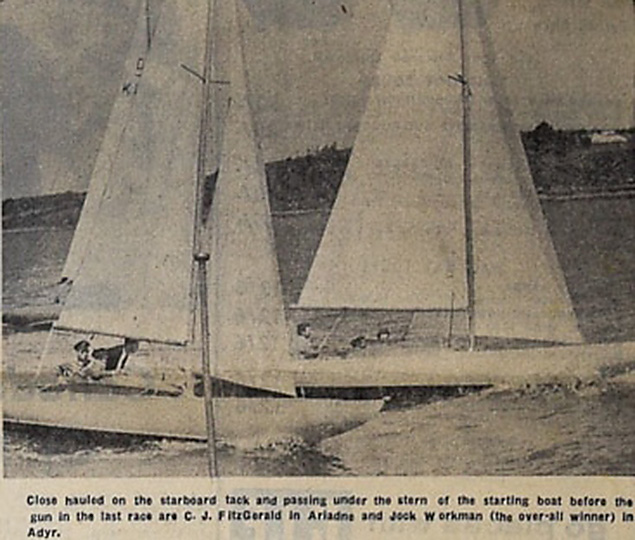 A photo from the Cork Evening Echo in 1962. The International Dragon Series at Crosshaven, with Joe Fitzgerald sailing for Cork Harbour (foreground) getting the better of eventual overall winner Jock Workman of Belfast Lough at the start
A photo from the Cork Evening Echo in 1962. The International Dragon Series at Crosshaven, with Joe Fitzgerald sailing for Cork Harbour (foreground) getting the better of eventual overall winner Jock Workman of Belfast Lough at the start
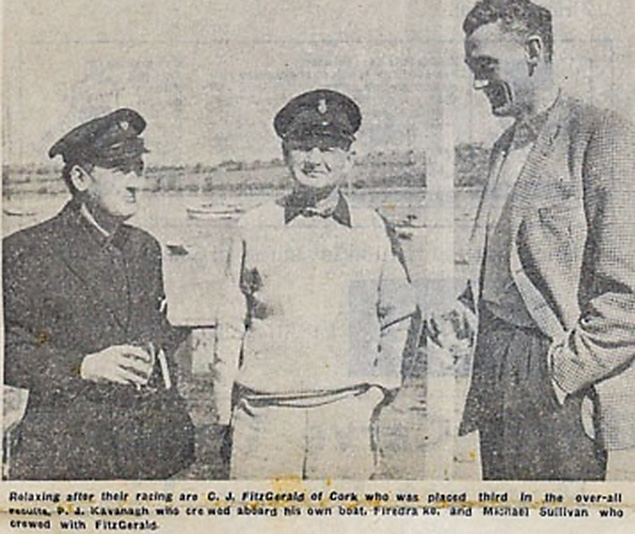 At the 1962 Dragon Open Series are skipper Joe Fitzgerald (left) with his crew of P J Kavanagh and Mick Sullivan
At the 1962 Dragon Open Series are skipper Joe Fitzgerald (left) with his crew of P J Kavanagh and Mick Sullivan
But increasingly he found most pleasure in cruiser-racers, and he teamed up with longtime friend Peter Cagney to order a new Cuthbertson & Cassian-designed Trapper 28, finished on a bare glassfibre hull by George Bushe at his new yard at Rochestown. It was now that Joe Fitzgerald really began to spread his wings, and every possible free moment was used for cruising, though their explorations were not without the occasional mishap.
Approaching Courtmacsherry long before it was a popular port of call, Peter was below and Joe was at the helm when they lightly clipped a rock. In response to the roar from below, the helmsman blithely replied: “Your half of the boat has just struck a rock, but it’s nothing serious……”
Building on experience over the years with his own boats and the larger vessels of friends, Joe Fitzgerald developed an entire philosophy of cruising in which he built up a complete matrix of friendly ports mostly on the Cork coast but also further afield and internationally too, and as well he showed how a place like Cork Harbour meant you could have a cruising weekend of some sort virtually regardless of what the weather might throw at you. And of course, if good conditions arrived, it was amazing what he could achieve by adding a day or two on to the beginning or the end of a favourable weekend.
To do this he maintained understanding friendships which provided lifelong bonds, and if other Cork sailors took to calling them “Dad’s Army”, Joe and his friends in turn showed a level of continuing love of boats and sailing which were inspirational to all. With such an approach, it was only natural that Joe Fitzgerald should be called upon to fill important roles in sailing administration, and while he could have his own way of doing things which was not always the way of other people, the very fact of his many sailing and cruising achievements often gave him carte blanche to continue the Fitzgerald administrative style, while his speeches at formal gatherings were gems to be treasured.
Thus having started at Honorary Secretary of Cork Harbour Sailing Club in 1946, he rose through many ranks, becoming Rear Commodore of the Royal Munster YC as long ago as 1949, and then when the Royal Munster and the Royal Cork merged during the late 1960s, the Royal Cork Quadrimillenial Celebrations of 1970 saw Joe in the key role of the still-extant position of Commodore which gave due recognition to the Royal Munster’s input, and then in 1975 he was RCYC Vice Admiral in support of George Kenefick as Admiral.
But it was in the Irish Cruising Club that the light-touch Fitzgerald management style proved most congenial. For many years he was on the Committee, by 1982 he was Vice Commodore, and he was then elected Commodore by acclamation from 1984 to 1986, heading the club with his calming presence at a time of rapid development.
Meanwhile his boat sizes had gently increased, and they reflected the reality of the needs of a sailor who continued in and around his boats afloat on a virtually year round basis. He moved up to a Moody 33 from the Trapper 28, and he was with that Moody 33 when we happened to drop into Youghal of a Saturday night in 1986 on our way to Cork Week in a 30-footer, and there was the Commodore ICC in fine form for a bit of a party, which duly took place.
By 1990 he’d moved on to a Moody Eclipse with its useful deckhouse, and we found ourselves in our little boat in Crosshaven waiting out a Sunday of filthy weather before better weather settled in to carry us south to Biscay. So Joe suggested that as he’d the deckhouse, we should go and spend the day with him on his boat over in East Ferry, and thus the bad weather was let go through without any interruption to the merriment, and next day we went on our way with a fair wind and sunshine, sustained by the entertaining memories of our thoughtful and imaginative clubmate back in Cork.
That’s the way it was with Joe Fitzgerald. He made the best of the hand that life dealt him. A widower since 1983, he still had 33 years to live, and he lived them with quiet enjoyment. He even decided he’d outgrown the Moody Eclipse, and bought himself a hefty Nauticat 33 which took on the Fitzgerald name of Mandalay, and provided an “all indoors” boat which enabled this most gallant senior sailor to continue his love affair with boats and the sea and boat people.
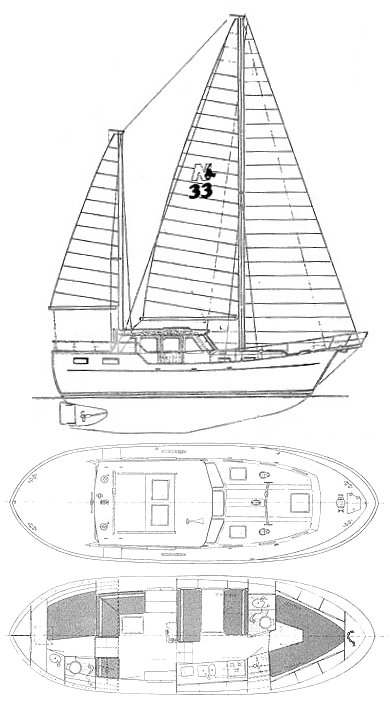 The “All Indoors” boat. The Nauticat 33 enabled Joe Fitzgerald to continue cruising until he’d become a very senior sailor.It is impossible to do full justice to Joe Fitzgerald in ordinary words. The world has been a much more interesting place for his having been in it. His view of life was unique. And his view of death was unusual. For his funeral service, he requested no more than a simple humanist ceremony. Yet we’re told one of the speakers with fond memories was a good old friend who was a former chaplain to the Naval Service at Haulbowline. In his quiet way, Joe Fitzgerald was beyond mere imagination, and he leaves family and friends with many cherished memories.
The “All Indoors” boat. The Nauticat 33 enabled Joe Fitzgerald to continue cruising until he’d become a very senior sailor.It is impossible to do full justice to Joe Fitzgerald in ordinary words. The world has been a much more interesting place for his having been in it. His view of life was unique. And his view of death was unusual. For his funeral service, he requested no more than a simple humanist ceremony. Yet we’re told one of the speakers with fond memories was a good old friend who was a former chaplain to the Naval Service at Haulbowline. In his quiet way, Joe Fitzgerald was beyond mere imagination, and he leaves family and friends with many cherished memories.
WMN
Irish Cruising – Sailing's Magic Elixir for a Long Life
#cruising – Cruising is the hidden side of sailing, yet it's the choice for the majority of those going afloat. Whether it's day cruising, a longer venture in the annual holidays, or the dream cruise of a lifetime across oceans, this is our sport. Unlike racing, which generates its own narrative even if only through the recorded results, much of cruising would slip under the radar completely were it not for cruising awards. W M Nixon considers the latest annual batch from the Irish Cruising Club.
Cruising under sail seems to be the secret of eternal youth. Last night's Annual General Meeting of the Irish Cruising Club in Dun Laoghaire saw a distribution of awards to voyagers from all parts of Ireland who sailed successfully in many areas of the globe in boats mostly of modest size. Yet any outside analyst would soon have made the point that many of the achievers were of mature – sometimes very mature - years, and fulfilling a retirement dream.
But despite any ICC membership gathering these days being a sea of silver heads, age is the last thing they think about. This club of 550 members has become the mixture of an Active Retirement Association – very active indeed, as it happens – and a sort of seagoing extension of the Men's Shed movement.
If you were looking for an illustration of Ireland's changing demographics, and our very rapidly changing attitude as to what constitutes old age, you need look no further than the ICC. Time was when it was thought quite something when one of the club achieved the Golden Jubilee of their membership. But these days, it's no big deal to have been on the strength for fifty years, as the senior member is Joe FitzGerald of Crosshaven, who this year marks 70 years in the club, and he is closely followed by Douglas Mellon who joined in 1947 from Howth - he now lives on the Scottish Riviera in Kircudbright.
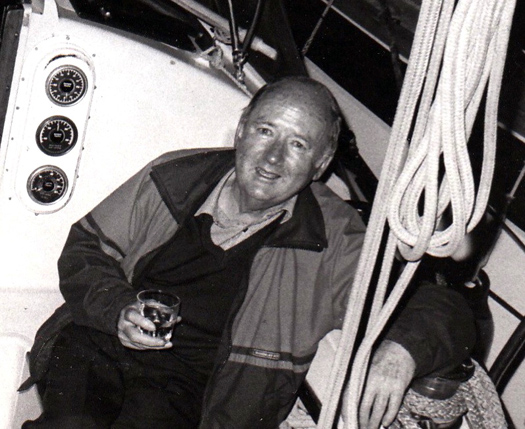
Joe FitzGerald of Cork is the ICC's most senior member, having joined in 1944. He served as Commodore from 1984 to 1987.
All those years ago when they took up their membership, it was thought perfectly normal for young men – married or otherwise - to take off for at least a fortnight's cruising every year, regardless of family demands which these days would be regarded as the prior commitment. In fact, nowadays so much emphasis is placed on family life and families doing just about every last recreational thing together, that younger married sailing people either do extremely short-hop cruising of the type necessitated by catering for the needs of all the members of the family, or else they don't cruise at all in the traditional sense - "Fun For All The Family" effectively rules out proper cruising.
Then too, modern life has so many other distractions - not least of them work demands which involve 24/7 attention - that the old-style easygoing simply-wandering-along holiday cruising is very much a minority activity. This means that at first it seems young people are not taking up traditional cruising at all. But with its deep experience garnered since its foundation in 1929, the Irish Cruising Club has learned to take the long view. It is not unduly concerned by the steadily rising age profile of its membership, and certainly every year there is a significant group of sometimes quite senior yet nevertheless increasingly active cruising enthusiasts joining the club.
They're the embodiment of the slogan that Sailing is a Sport for Life, and it's only politeness which prevents them saying that the subtle pleasures of cruising are wasted on the young. So when you look at the lineup of achievement represented by last night's awards, it's natural to wonder what these people did in earlier life, that they can nowadays afford the time, resources and dedication necessary to complete voyages of this quality.
The adjudication was done by Dave Whitehead of Kinvara on Galway Bay, himself no stranger to the ways of the sea while making long voyages in small craft. He breaks new ground by awarding three trophies at once to Sam Davis of Strangford Lough, whose Cape Horn and Pacific ventures with his Rival 41 Suvretta have been quietly bubbling away in the background of ICC activity for the past three years.
Sam Davis first featured in Afloat magazine in March and April 1981 when we ran his two-part account of his first ocean voyage, an Atlantic circuit from Strangford Lough between 1976 and 1979 with the 34.5ft West Solent Class Suvretta, a former racing boat he'd found in a derelict state and restored to ocean-going condition.

The 34ft West Solent class Suvretta in her offshore racing days in the 1950s when she was based in Belfast Lough. When Sam Davis did the Atlantic Circuit cruise with her in 1976-79, she carried a less loft mainmast, with masthead rig.
But even with Sam's improvements, she was still no more than a slip of a boat, so it says much for his grit and skill that he brought her through the Fastnet storm of 1979 as he sailed the final hundred miles back to Ireland. There was damage aloft, and he'd to get into Dunmore East unaided with jury rigging, but the job was done.
While in the Caribbean, he'd worked in charter yachts between times to make a shilling or two. But after he'd spent time back in Northern Ireland, he went abroad into serious seafaring in offshore service industries, working in places like The Gulf, the North Sea, the Amazon, the Red Sea and Malaysia, becoming a fully accredited Marine Consultant.
Yet if you ask him nowadays what he is and what he was, he'll say he's a farmer and former seaman, as his purchase some years ago of Conly Island in Strangford Lough (you can drive out to it when the tide is down) gives him the little bit of land, and an anchorage too, while "seaman" covers his many experiences in offshore work.
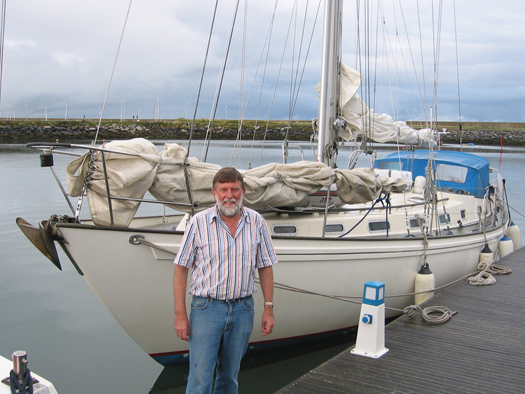
Sam Davis with his newly-acquired Rival 41, re-named Suvretta, in 2009. Photo: W M Nixon

Suvretta in the Beagle Channel in southern Chile. Photo: Sam Davis
Back in 2009 he bought a Rival 41, a hefty and able vessel, a sister-ship of Waxwing in which fellow ICC members Peter and Susan Gray of Dun Laoghaire went round the world 14 years ago. Sam re-named his new boat Suvretta, spent the winter sorting her out, and in 2010 he was gone, sailing south single-handed to eventually round Cape Horn and then spend a long time on the coast of Chile. He was delayed there as a ship broke drift and damaged the boat, but it was well fixed, and he voyaged on into the Pacific to many islands, including Pitcairn and the Tahiti group.
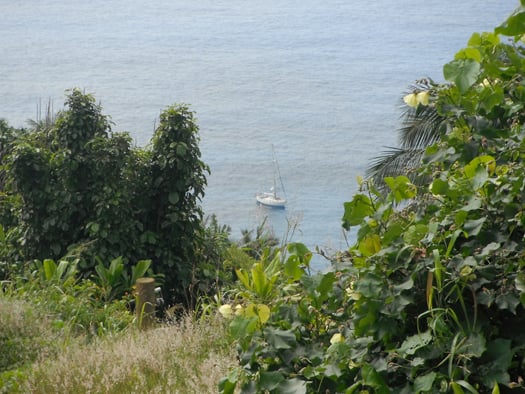
Restless anchorage. Suvretta in Bounty Bay on Pitcairn Island. Photo: Sam Davis
Eventually he fetched up for some time in Tonga, where he became enthused about the 73ft Vakas, the Pacific islanders' contemporary take on the classic Polynesian inter-island vessels (see Sailing on Saturday 11th January 2014). But by November 2012 it was time to head for home, so Suvretta sailed southeast for Cape Horn non-stop, and having rounded it, shaped her course for Port Stanley in the Falklands.
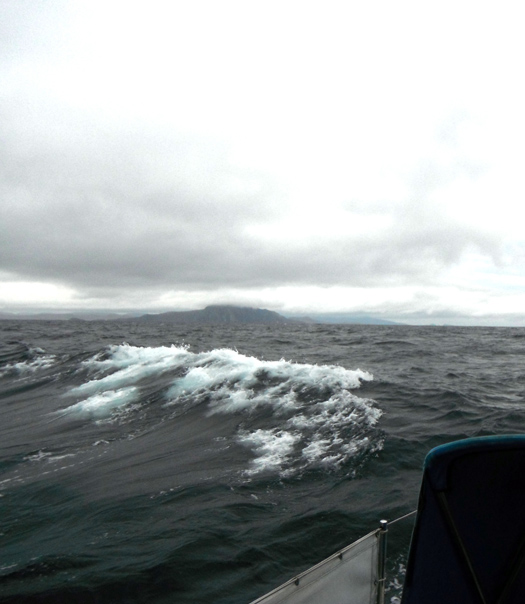
Suvretta rounding Cape Horn for the second time, 21st January 2013. It was only when the Horn was well astern that the weather deteriorated rapidly to make for a challenging approach to Port Stanley. Photo: Sam Davis
However, while rounding the Horn had been simple enough, the passage onwards to Stanley became increasingly fraught, running before rising storm force winds. Conditions were such that it looked for a while as though the lone sailor was going to be swept right past the islands, but he made the cut into shelter to such a nicety that he is awarded the ICC's Rockabill Trophy for Seamanship.
And then when Port Stanley was reached, a very fine passage had been completed from Tonga, so last night for that he was additionally awarded the ICC's Atlantic Trophy for the best voyage with a non-stop leg of more than a thousand miles. And then finally, after they'd spent the mid part of 2013 working their way up the Atlantic with the lone skipper particularly enjoying himself at ports on the Irish coast, Suvretta and Sam returned after three years to Conly Island. And they'd now done more than enough to also be awarded a third trophy - the ICC's premier honour, the Faulkner Cup.

Home again. Sam Davis back in Ireland, August 2013. Photo: W M Nixon
With such a high level of activity by many members, ICC adjudicators always find some final choices to be a very close call, so some years ago the Strangford Cup was inaugurated for the cruise which almost won the Faulkner Cup. This year it has gone to a fine cruise from Portugal to Madeira and through the Azores in detail before returning to Portugal.
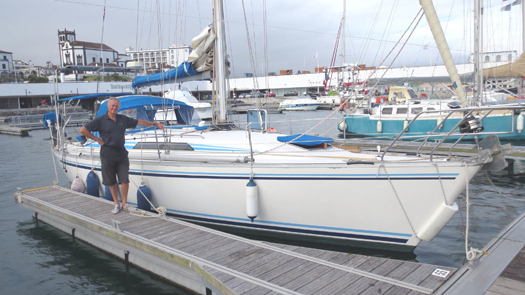
John Duggan with his MG CS40 Hecuba in Horta in the Azores
John Duggan originally hailed from Malahide where he sailed, and he also sailed with the college teams while at Trinity College in Dublin. He cruised and raced offshore mostly in the Irish Sea, but having qualified as an accountant he decided to spread his wings internationally, and he became one of those key people who turn up as partners in one of the big four accountancy firms worldwide.
Eventually his career brought him to the company's offices in Lisbon. Living in Portugal suited him fine, so he put down roots and in time bought himself an interesting cruiser. Hecuba is a 1989 Canadian-built Tony Castro-designed MG CS40, a handsome 12m craft with good performance enhanced by an effective wing keel.
During his final years in the day job he gradually improved the boat with a mind to some proper cruising once he retired at 60, something which he planned with all a high-powered accountant's meticulous attention to detail. He remembers the final day at the office, when a friend on the other side of the world sent him an email: "Even the worst day of your retirement will be better than the best day at work".

Azorean whaleboat with Pico beyond seen during one of Hecuba's cruises from Portugal to the Azores. Photo: John Duggan
Maybe so, yet not everyone makes the changeover smoothly, but in John Duggan's case the challenge of planning and executing remarkably civilised yet challenging cruises has proven to be a complete new job in itself, but much more fun than number crunching. He goes to enormous trouble to make sure that his crews have as enjoyable and varied an experience as possible, yet all the time he is quietly keeping the project moving along while noting details and features of ports visited which might be of interest to fellow skippers, a habit which is the hallmark of the true cruising man.
When you live in Cascais with your boat based in the marina nearby, the Azores are the western isles which call you each summer. But unlike Scotland's Western Isles which are just a day's sail away across the Sea of the Hebrides, the Azores involve an immediate ocean voyage from Portugal of at least 500 miles. However, for 2013's cruise west, Hecuba made it a triangle, going first to Madeira before going on nor'west to the Azores which were cruised in detail before returning to Cascais after six weeks away, having logged 2390 miles, with the final tabulation being:
Hours spent close hauled: Zero.
Cross words exchanged: Zero.
Inevitably the two big awards dominate the scoresheet, but the ICC also has a host of trophies which reflect every level of club sailing activity. The Round Ireland Cup, for instance, is for the circuit which produces most information for the club's sailing directions, and in a year in which a goodly number went round, it was Donal Walsh of Dungarvan with his Moody 31 Lady Kate who best filled the bill.

Donal Walsh's Lady Kate anchored at Inishmurray off the Sligo coast during his detailed round Ireland cruise. Photo: Donal Walsh
As the Faulkner Cup was first won in 1931 by the 28ft cutter Marie, the Marie Trophy is for the best cruise by a boat under 30ft, and Mick Delap from Valentia Island with his Tamarisk 24 gaff cutter North Star fits into the size requirement with six feet to spare. He made a fine job of completing a two-summer circuit of Ireland by returning from western Scotland via the Irish Sea and Ireland's south and southwest coasts.

Mick Delap's Tamarisk 24 North Star from Valentia in Lowlandman's Bay in Jura in the Hebrides. Photo: Mick Delap
In all, the ICC has a dozen cruising trophies. But even so not everyone gets one in a typically busy year, so to encourage the newcomers they've the Perry Greer Trophy for first time log-writers, and it goes to Peter Mullan from the Quoile in Strangford Lough for his insightful account of a round Ireland cruise with the Jeanneau Sun Odyssey Sancerre.
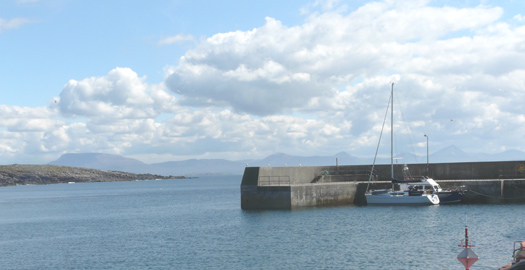
Peter Mullan's Sun Odyssey Sancerre in the little harbour at Tory Island with the Donegal highlands beyond. Photo: Peter Mullan
All the logs, including the winning ones, were featured in the ICC's 180-page Annual 2013, which Honorary Editor Ed Wheeler managed to get to the members in time for Christmas. All this is done by voluntary effort, yet the Annual would stand up to professional comparisons, as it includes informative accounts of cruises in just about every part of the world, plus a report on the ICC Cruise-in-Company to the Isles of Scilly which was an outstanding success despite coinciding with some uneven weather in June.
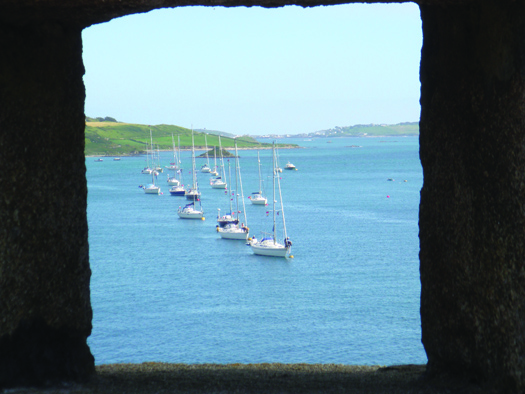
The Irish Cruising Club flotilla in the Isles of Scilly during their successful Cruise-in-Company in June 2013.

Everyone to his taste. ICC member Brian Black went to Greenland for the sixth time, crewing on Aurora. This is Kangertitiatsivaq Fjord in high summer. Photo: Brian Black
There's more to the Club than the Annual, as the ICC's programme of producing constantly up-dated Sailing Directions for the entire Irish coast in two volumes is a continuous progression, with the latest 12th Edition of the North & East Coast Book due next month from Honorary Editor Norman Kean, whose home port is Courtmacsherry.
Thus it's clear that Ireland's cruising club is a truly all-Ireland organisation, and this year it will be celebrating its 85th birthday with a Cruise-in-Company to Glengarriff where it was founded on July 13th 1929. Yet despite its obvious significance, this is a club without premises. In the final analysis, it's a club of the mind, made up of kindred spirits. Heading such a body is a mighty challenge, and the changing of the watch is always a charged moment.
Last night David Tucker of Kinsale stood down after serving his three years as Commodore, and he was succeeded by Peter Killen of Malahide. His experience in club administration is long-lived – he was Commodore of Malahide YC when it became "Club of the Year" in 1980. But it was his cruising CV which next went into overdrive, as in 1993 he voyaged north to Iceland, circled it, and then sailed back in near-record time in an S&S 30. He then moved up to a Sigma 36 which he cruised to Greenland among other places, following which he cruised even further with a Sweden 38, and then in 2004 he took on his dreamship, the Amel Maramu 54 Pure Magic.
Peter Killen seems to have cruised this very special boat just about everywhere. Not least was deep into Antarctica, where he made a memorable arrival in zero visibility with icy conditions into the natural harbour in the extinct volcanic crater on Deception Island. It was all a long way in time and distance from five boats gathered in Glengarrif in the hope of forming a little cruising organisation back in 1929. But that's the way it is with the Irish Cruising Club.































































